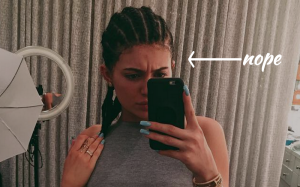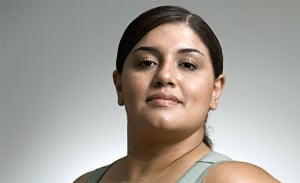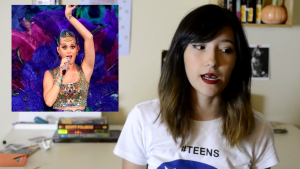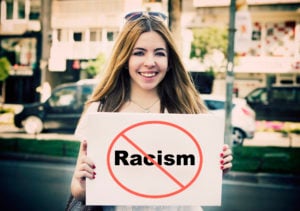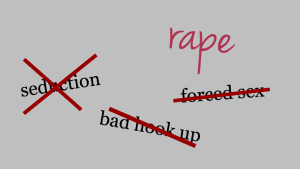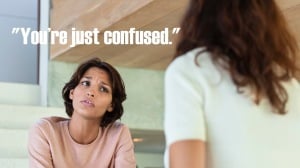Originally published on Fembot and republished here with their permission.
I distinctly remember the day a classmate described me as the only black student in my entire program as an undergraduate. You’d think I’d be shocked by this statistic but truthfully, I was more shocked with myself: I hadn’t even noticed.
I am a “mixed” woman in my twenties attending art school in Los Angeles. What I realized in this moment was that I was so entirely used to being the “only one” in so many public and educational settings, I had (flat out) gotten used to it.
Prior to attending California Institute of the Arts, I was pretty oblivious to my African-American culture. My family, my high school student body and the city I lived in were completely white in majority.
Because this part of my identity was never celebrated, I learned to ignore it and internalize feelings of isolation and resentment.
This was certainly a case of internalized racism and these feelings were the outcome of identifying myself as non-white as opposed to black. This means I saw myself in terms of what I wasn’t instead of what I was. It seems like such a small distinction in thought, but it really took a toll on my opinion of myself as a woman of color and as a whole individual.
Internalized racism is often understood by outsiders simply as low self-esteem, color prejudice (or colorism), stereotyping and self-hatred. While these can definitely be feelings a victim of internalized racism may feel, this is totally not looking at the big picture.
Just how racism is a systematic form of oppression, internalized racism is systematic in its nature as well. In other words, just how there is a system in place that reinforces the privilege of white people, there is a system that discourages the power of people of color.
This system is upheld at its foundation by punishment and reward. How many times have we felt excluded when we have not “reached” the white, female beauty standard? This is a shame because I think black hair is beautiful just as is. (And yes, under this system, even natural black hair can be totally viewed as a political statement).
It’s important to understand internalized racism as systemic because it makes it clear that this is not a problem of individuals, it’s structural. It took me time to understand this and forgive myself.
I wanted to be more apart of my culture and heritage; however, the invisibility of my culture in public space made me feel isolated. That is what I truly resented, not the color of my skin.
In my environment and in my social circle, blackness was viewed as absence of whiteness rather than blackness existing beautifully without relying on whiteness for context. People of color may easily fall victim to internalizing oppression, as I did.
In the past, I believed being a woman of two races meant dealing with existing in the dreaded liminal space. This means I truly felt I was not black enough for one category, not white enough for the other. Many mixed women I’ve talked to have felt similar.
It’s a feeling of isolation internalized from receiving comments over the years like, “You’re the whitest black girl I’ve ever met” or (and I’m not even kidding) “You’re pretty for a black girl.”
It was in my first year at CalArts that I staged managed a play directed by Nataki Garrett, an acting professor and theater artist who admirably takes the issues of race head-on in her career.
Even though I was working “behind the scenes,” I was put in a position to question ethnic and racial dynamics on campus and to challenge my own apathy towards my racial identity. It only took bringing to life one play with this amazing woman that I began to feel liberated from my oppressive ways of thinking.
Shortly after, I was invited to my first ever It’s a Sistah Thang. This event was described as a gathering of “the black women of CalArts School of Theater: past, present and future.” Little did I know this event would change my entire experience at CalArts.
It’s a Sistah Thang was attended by students, alumni, and faculty. I was simply overwhelmed and overjoyed by being in a room with so many beautiful, powerful artists all at one time. We discussed the experiences in our lives, on our campus, and in our art making as women of color. I felt encouraged to discuss my life in a racial context.
I soon realized going home that I had found the community of women I had unconsciously been searching for.
I previously could not articulate this need because I simply did not have the language or have the access to an environment in order to discuss the complexities of my experience. At It’s a Sistah Thang, it felt a lot like I was lost and then I was found.
After the event, I had heard through the grapevine that some Caucasian students felt left out that they were not invited. In addressing this issue, I am reminded of a co-worker of mine who made a comment about wanting a “White History Month” just like a Black History Month. I remember telling him with a smile, “Don’t you have one every month of the year?”
The same goes for events like It’s a Sistah Thang. Friends that attended this event with me felt as if there was finally a space in which to openly talk about anything. (Even issues that white students can understand but cannot relate to because of the privilege that comes with being white).
I believe now that privilege is something that should be openly discussed between peers, especially in the artistic world. I find myself battling with having privilege in some situations and not having privilege in others based on my mixed racial identity.
For instance, as a writer, I most likely will be published as a “black, female author” as opposed to just a “writer” which would be the description for a white male writer. This example alludes to the notion that “white” or “male” is considered invisible rather than defining, as my race and sex are.
Being aware of these differences has led me to critically think about my race in a larger, social, and political world. It has also led me to seek out and strengthen my relationships with black women (and all women), and I now see us as allies rather than competition.
I would have never gotten to this place of acceptance and camaraderie with other women if I was looking at myself through a mainstream patriarchal lens.
That why gatherings like It’s a Sistah Thang are so important for women of color (and all women). It’s about creating spaces in which we can express ourselves at our most free, about finding a community that creates its own, positive and authentic context and reclaiming blackness and embracing its complexities on our own terms.
In the past, we’ve seen groups like It’s a Sistah Thang change the course of history in the Women’s and Civil Rights movements. Their success reminds me we are in good company and should continue living radically and unapologetically as women of color today.
The next steps in my journey of self discovery and acceptance is learning how to give back to my community by creating artistic work that is racially aware and that constantly questions the issues of privilege.
Aleshea Harris, a MFA graduate, playwright and CalArts faculty member who attended It’s a Sistah Thang, gave me some guidelines on these next steps.
I asked her for advice for young, black women searching for community. She answered, “[f]ind community with other black girls/women and nurture it. Take care of yourself, ask for help and go where the love is. Coming into one’s own means having a level of self-awareness and feeling ownership over one’s experience as a human being. Seek happiness. You deserve it.”
This is some advice I am taking to heart.
[do_widget id=’text-101′]
Salina Mahoney is a Bachelor of Fine Arts candidate at California Institute of the Arts in Los Angeles majoring in Theater Management, minoring in Creative Writing. She has a passion for literature and her interests include poetry, novella, graphic text and playwriting. This Instagramaholic (@salinamyhoney) and hot tea enthusiast hopes to explore Black issues and culture, sex and sexuality and feminism in her next frontier: online journalism.
Search our 3000+ articles!
Read our articles about:
Our online racial justice training
Used by hundreds of universities, non-profits, and businesses.
Click to learn more
Most Read Articles
- « Previous
- 1
- …
- 30
- 31
- 32








